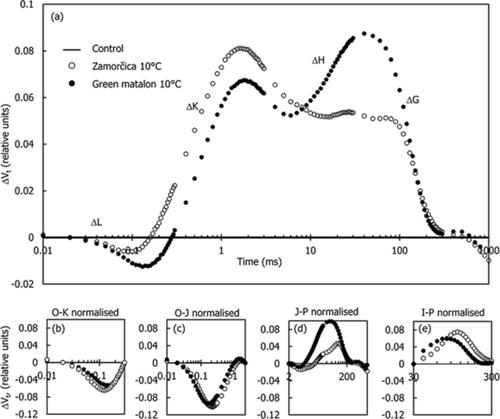当前位置:
X-MOL 学术
›
Ann. Appl. Biol.
›
论文详情
Our official English website, www.x-mol.net, welcomes your feedback! (Note: you will need to create a separate account there.)
Antioxidative response and photosynthetic regulatory mechanisms in common fig leaves after short‐term chilling stress
Annals of Applied Biology ( IF 2.6 ) Pub Date : 2021-01-03 , DOI: 10.1111/aab.12671 Selma Mlinarić 1 , Vera Cesar 1, 2 , Hrvoje Lepeduš 2, 3
Annals of Applied Biology ( IF 2.6 ) Pub Date : 2021-01-03 , DOI: 10.1111/aab.12671 Selma Mlinarić 1 , Vera Cesar 1, 2 , Hrvoje Lepeduš 2, 3
Affiliation

|
Common fig (Ficus carica L.) is widely cultivated Mediterranean species. Such warm‐climate species are adapted to elevated temperatures and are susceptible to chilling stress (0–12°C). However, occasional short chilling periods are common during growing season in temperate areas that can affect functionality of the plant. The aim of this work was to investigate influence of short‐term chilling stress on antioxidative response and PSII photochemistry in developing leaves of two common fig varieties: Zamorčica and Green matalon. Leaves were detached from the trees, acclimated at room temperature in dark for 16 hr and then exposed to low temperature (10°C) at low irradiation (50 μmol m−2 s−1) for 4 hr. Dark adapted leaves were considered as the control. The damage to the membranes was determined as lipid peroxidation (thiobarbituric acid reactive substances) while the antioxidative response was evaluated by determining activities of the selected antioxidative enzymes. Photosynthetic performance was analysed by measuring in vivo chlorophyll a fluorescence (ChlF) increase. Relative accumulation of the main photosynthetic proteins (D1 and Rubisco LSU) was determined, as well. Due to efficient antioxidative activity, neither of investigated variety showed damage of the membrane lipids. Both varieties revealed functional antennae and its good connectivity to their reaction centres shown as negative L and K bands as well as stable D1 protein accumulation suggesting functional electron transport through photosystem II (PSII) and efficient primary photochemistry. Blocked electron flow further than QA resulted in limitation of the Photosystem I (PSI) functionality in both varieties. Due to differential relative accumulation of D1 and Rubisco LSU proteins upon the chilling stress, Zamorčica revealed greater decrease of the main photosynthetic parameters derived from in vivo ChlF induction (PItotal, PIABS and φP0) in comparison to Green matalon. In addition, increased specific energy fluxes through PSII in Zamorčica suggested its higher susceptibility to photoinhibition caused by chilling stress in comparison to Green matalon.
中文翻译:

短期冷胁迫后普通无花果叶的抗氧化反应和光合调节机制
无花果(Ficus carica L.)是地中海地区广泛种植的物种。这种温暖的气候物种适应高温,并容易受到寒冷胁迫(0–12°C)的影响。但是,在温带地区,生长季节偶尔会出现短暂的低温天气,这可能会影响植物的功能。这项工作的目的是调查短期低温胁迫对两个普通无花果品种Zamorčica和Green matalon叶片发育中抗氧化反应和PSII光化学的影响。将叶子从树上摘下,在黑暗中于室温下适应16小时,然后在低辐射(50μmolm -2 s -1)下暴露于低温(10°C))4小时。深色适应叶片被认为是对照。膜的损伤确定为脂质过氧化(硫代巴比妥酸反应性物质),而抗氧化反应则通过确定所选抗氧化酶的活性来评估。通过测量体内叶绿素a分析光合性能荧光(ChlF)增加。还确定了主要光合蛋白(D1和Rubisco LSU)的相对积累。由于有效的抗氧化活性,所研究的品种均未显示出膜脂质的损害。两种变种都显示出功能性触角,并且与它们的反应中心具有良好的连通性,表现为负L和K带,以及稳定的D1蛋白积累,表明功能性电子通过光系统II(PSII)的转运和有效的初级光化学反应。阻止电子流超过Q A导致这两个品种的Photosystem I(PSI)功能受到限制。由于在所述冷胁迫D1和Rubisco的LSU蛋白的差异相对积累,Zamorčica揭示从体内CHLF感应得到的主要光合参数的更大的下降(PI总,PI ABS和φ P0)相比于绿色matalon。此外,与Zamatčica相比,通过PSII增加的比能通量表明,与绿色Matalon相比,其对冷胁迫引起的光抑制的敏感性更高。
更新日期:2021-01-03
中文翻译:

短期冷胁迫后普通无花果叶的抗氧化反应和光合调节机制
无花果(Ficus carica L.)是地中海地区广泛种植的物种。这种温暖的气候物种适应高温,并容易受到寒冷胁迫(0–12°C)的影响。但是,在温带地区,生长季节偶尔会出现短暂的低温天气,这可能会影响植物的功能。这项工作的目的是调查短期低温胁迫对两个普通无花果品种Zamorčica和Green matalon叶片发育中抗氧化反应和PSII光化学的影响。将叶子从树上摘下,在黑暗中于室温下适应16小时,然后在低辐射(50μmolm -2 s -1)下暴露于低温(10°C))4小时。深色适应叶片被认为是对照。膜的损伤确定为脂质过氧化(硫代巴比妥酸反应性物质),而抗氧化反应则通过确定所选抗氧化酶的活性来评估。通过测量体内叶绿素a分析光合性能荧光(ChlF)增加。还确定了主要光合蛋白(D1和Rubisco LSU)的相对积累。由于有效的抗氧化活性,所研究的品种均未显示出膜脂质的损害。两种变种都显示出功能性触角,并且与它们的反应中心具有良好的连通性,表现为负L和K带,以及稳定的D1蛋白积累,表明功能性电子通过光系统II(PSII)的转运和有效的初级光化学反应。阻止电子流超过Q A导致这两个品种的Photosystem I(PSI)功能受到限制。由于在所述冷胁迫D1和Rubisco的LSU蛋白的差异相对积累,Zamorčica揭示从体内CHLF感应得到的主要光合参数的更大的下降(PI总,PI ABS和φ P0)相比于绿色matalon。此外,与Zamatčica相比,通过PSII增加的比能通量表明,与绿色Matalon相比,其对冷胁迫引起的光抑制的敏感性更高。



























 京公网安备 11010802027423号
京公网安备 11010802027423号